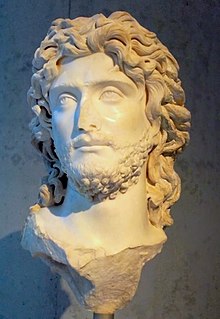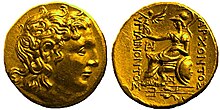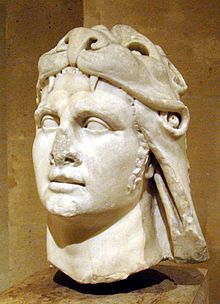List of kings of the Cimmerian Bosporus: Difference between revisions
Rheskouporis (talk | contribs) No edit summary |
Rheskouporis (talk | contribs) No edit summary |
||
| Line 2: | Line 2: | ||
The '''Bosporan kings''' were the rulers of the [[Bosporan Kingdom]], an ancient [[Hellenistic period|Hellenistic]] Greco-[[Scythians|Scythian]] state centered on the [[Kerch Strait]] (the Cimmerian Bosporus) and ruled from the city of [[Panticapaeum]]. Panticapaeum was founded in the 7th or 6th century BC; the earliest known king of the Bosporus is [[Archaeanax]], who seized control of the city {{Circa}} 480 BC as a usurper.<ref name=":3">{{Cite book |last=Schneider |first=Helmuth |url=https://books.google.com/books?id=3KpmAAAAMAAJ |title=Brill's New Pauly: Chronologies of the ancient world : names, dates and dynasties |date=2007 |publisher=Brill |isbn=978-90-04-15320-2 |pages=112 |language=en}}</ref> The [[Archaeanactid dynasty]] ruled the city until it was displaced by the more long-lived [[Spartocid dynasty]] in 438 BC.<ref name=":3" /> After ruling for over three centuries, the Spartocids were then displaced by the [[Mithridatic dynasty]] of [[Kingdom of Pontus|Pontus]] and then its offshoot the [[Tiberian-Julian dynasy]]. The Tiberian-Julian kings ruled as [[Client king|client kings]] of the [[Roman Empire]] until [[late antiquity]]. |
The '''Bosporan kings''' were the rulers of the [[Bosporan Kingdom]], an ancient [[Hellenistic period|Hellenistic]] Greco-[[Scythians|Scythian]] state centered on the [[Kerch Strait]] (the Cimmerian Bosporus) and ruled from the city of [[Panticapaeum]]. Panticapaeum was founded in the 7th or 6th century BC; the earliest known king of the Bosporus is [[Archaeanax]], who seized control of the city {{Circa}} 480 BC as a usurper.<ref name=":3">{{Cite book |last=Schneider |first=Helmuth |url=https://books.google.com/books?id=3KpmAAAAMAAJ |title=Brill's New Pauly: Chronologies of the ancient world : names, dates and dynasties |date=2007 |publisher=Brill |isbn=978-90-04-15320-2 |pages=112 |language=en}}</ref> The [[Archaeanactid dynasty]] ruled the city until it was displaced by the more long-lived [[Spartocid dynasty]] in 438 BC.<ref name=":3" /> After ruling for over three centuries, the Spartocids were then displaced by the [[Mithridatic dynasty]] of [[Kingdom of Pontus|Pontus]] and then its offshoot the [[Tiberian-Julian dynasy]]. The Tiberian-Julian kings ruled as [[Client king|client kings]] of the [[Roman Empire]] until [[late antiquity]]. |
||
After several successive periods of rule by groups such as the [[Sarmatians]], [[Alans]], [[Goths]] and [[Huns]],<ref name=":0" /> the remnants of the Bosporan Kingdom |
After several successive periods of rule by groups such as the [[Sarmatians]], [[Alans]], [[Goths]] and [[Huns]],<ref name=":0" /> the remnants of the Bosporan Kingdom were finally absorbed into the Roman Empire by [[Justinian I]] in the 6th century AD.<ref>{{Cite journal |last=Frolova |first=N. |date=1999 |title=The Question of Continuity in the Late Classical Bosporus On the Basis of Numismatic Data |url=https://brill.com/view/journals/acss/5/3/article-p179_12.xml |journal=Ancient Civilizations from Scythia to Siberia |language=en |volume=5 |issue=3 |pages=179–205 |doi=10.1163/157005799X00188 |issn=0929-077X}}</ref><ref>{{Cite book |last=Lawler |first=Jennifer |url=https://books.google.com/books?id=sEWeCQAAQBAJ |title=Encyclopedia of the Byzantine Empire |date=2015 |publisher=McFarland |isbn=978-1-4766-0929-4 |pages=137 |language=en}}</ref> |
||
== List of kings == |
== List of kings == |
||
Revision as of 20:12, 21 May 2022

The Bosporan kings were the rulers of the Bosporan Kingdom, an ancient Hellenistic Greco-Scythian state centered on the Kerch Strait (the Cimmerian Bosporus) and ruled from the city of Panticapaeum. Panticapaeum was founded in the 7th or 6th century BC; the earliest known king of the Bosporus is Archaeanax, who seized control of the city c. 480 BC as a usurper.[1] The Archaeanactid dynasty ruled the city until it was displaced by the more long-lived Spartocid dynasty in 438 BC.[1] After ruling for over three centuries, the Spartocids were then displaced by the Mithridatic dynasty of Pontus and then its offshoot the Tiberian-Julian dynasy. The Tiberian-Julian kings ruled as client kings of the Roman Empire until late antiquity.
After several successive periods of rule by groups such as the Sarmatians, Alans, Goths and Huns,[2] the remnants of the Bosporan Kingdom were finally absorbed into the Roman Empire by Justinian I in the 6th century AD.[3][4]
List of kings
Joint rulers are indicated with indentation.
Archaeanactid dynasty (c. 480–438 BC)
- Archaeanax c. 480 BC–?[1]
The names and number of Archaenax's successors is not known, but they ruled until c. 438 BC.[1]
Spartocid dynasty (438–111 BC)


- Spartokos I 438–433 BC[5]
- Satyros I 433–389 BC[5]
- Leukon I 389–349 BC[5]
- Paerisades I 349–311 BC[5]
- Spartokos II 349–344 BC[5]
- Satyros II 311–310 BC[5]
- Prytanis 310–309 BC[5]
- Eumelos 309–304 BC[5]
- Spartokos III 304 BC–284 BC[5]
- Paerisades II 284–c. 250 BC[5]
- Spartokos IV c. 250–c. 240 BC[5]
- Leukon II c. 240–210 BC[5]
- Hygiainon c. 210–c. 200 BC[5]
- Spartokos V c. 200–c. 180 BC[5]
- Kamasarye c. 180–c. 160 BC[5]
- Paerisades III c. 180–c. 170 BC[5]
- Paerisades IV c. 170–c. 150 BC (with Kamasarye and then alone)[5]
- Spartokos VI (?) c. 150–c. 140 BC[5]
- Paerisades V c. 140–111 BC[5]
Scythian rule (111–110 BC)
Mithridatic dynasty (110 BC–AD 8)

- Mithridates I 110 BC–63 BC[5]
- Pharnaces 63–48 BC[5]
- Dynamis & Asander 48–47 BC (first reign)[7]
- Mithridates II 47 BC–44/43 BC[7][8]
- Dynamis 44/43 BC–c. AD 7/8 (second reign), with husbands:[5][9][10]
Tiberian-Julian dynasty (8–341)


- Aspurgus 8/10–38 AD[5][11]
- Polemon II of Pontus 38–41[11]
- Rhescuporis I (?) 14–42[11]
- Mithridates III 42–46[11]
- Cotys I 46–78[11]
- Incorporated as a part of the Roman Province of Moesia Inferior 63–68
- Rhescuporis II 78–93[11]
- Sauromates I 93–123[11]
- Cotys II 123–131[11]
- Rhoemetalces 131–153[11]
- Eupator 154–170[11]
- Sauromates II 172–210[11]
- Rhescuporis III 211–228[11]
- Cotys III 228–234[11]
- Sauromates III 229–232[11]
- Rhescuporis IV 233–234[11]
- Chedosbios 233–234 (?)[12]
- Ininthimeus 234–239[11] (possibly non-dynastic)[13]
- Rhescuporis V 240–276[11]
- Pharsanzes 253–254[11] (possibly non-dynastic)[14]
- Teiranes 276–278[11]
- Theothorses 279–309[11] (possibly non-dynastic)[2]
- Rhadamsades 309–322[15] (possibly non-dynastic)[2]
- Rhescuporis VI 314–341[15][16]
Later rulers (341–527)
The end of Rhescuporis VI's reign is believed to have marked the end of the Tiberian-Julian dynasty. Details of the Bosporan kingdom are scant thereafter, when the kingdom underwent several successive periods of rule by Sarmatians, Alans, Goths and Huns.[2]
- Douptounos fl. c. 483[2]
- Gordas fl. 527[17]
Family tree
This family tree covers the rulers of the Mithridatic and Tiberian-Julian dynasties. Owing to much of the sequence of Tiberian-Julian rulers being based on coinage, the relationships within the Tiberian-Julian dynasty (especially for later rulers) are largely conjectural and speculative. Conjectural and speculative lines of descent are marked with dotted lines. Though genealogical information is completely unknown for kings after Cotys III, the repeating names lead most researchers to believe that the later kings were part of the same continuous dynasty.[1]
| Family tree of the Mithridatic and Tiberian-Julian dynasties | |||||||||||||||||||||||||||||||||||||||||||||||||||||||||||||||||||||||||||||||||||||||||||||||||||||||||||||||||||||||||||||||||||||||||||||||||||||||||||||||||||||||||||||||||||||||||||||||||||||||||||||||||||||||||||||||||||||||||||||||||||||||||||||||||||||||||||||||||||||||||||||||||||||||||||||||||||||||||||||||||||||||||||||||||||||||||||||||||||||||||||||||||||||||||||||||||||||||||||||||||||||||||||||||||||||||||||||||||||||||||||||||||||||||||||||||||||||||||||||||||||||||||||||||||||||||||||||||||||||||||||||||||||||||||||||||||||||||||||||||||||||||||||||||||||||||||||||||||||||||||||||||||||||||||||||||||||||||||||||||||||||||||||||||||||||||||||||||||||||||||||||||||||||||||||||||||||||||||||||||||||||||||||||||||||||||||||||||||||||||||||||||||||||||||||||||||||||||||||||||||||||||||||||||||||||||||||||||||||||||||||||||||||||||||||||||||||||||||||||||||||||||||||||||||||||||||||||||||||||||||||||||||||||||||||||||||||||||||||||||||||||||||||||||||||||||||||||||||||||||
|---|---|---|---|---|---|---|---|---|---|---|---|---|---|---|---|---|---|---|---|---|---|---|---|---|---|---|---|---|---|---|---|---|---|---|---|---|---|---|---|---|---|---|---|---|---|---|---|---|---|---|---|---|---|---|---|---|---|---|---|---|---|---|---|---|---|---|---|---|---|---|---|---|---|---|---|---|---|---|---|---|---|---|---|---|---|---|---|---|---|---|---|---|---|---|---|---|---|---|---|---|---|---|---|---|---|---|---|---|---|---|---|---|---|---|---|---|---|---|---|---|---|---|---|---|---|---|---|---|---|---|---|---|---|---|---|---|---|---|---|---|---|---|---|---|---|---|---|---|---|---|---|---|---|---|---|---|---|---|---|---|---|---|---|---|---|---|---|---|---|---|---|---|---|---|---|---|---|---|---|---|---|---|---|---|---|---|---|---|---|---|---|---|---|---|---|---|---|---|---|---|---|---|---|---|---|---|---|---|---|---|---|---|---|---|---|---|---|---|---|---|---|---|---|---|---|---|---|---|---|---|---|---|---|---|---|---|---|---|---|---|---|---|---|---|---|---|---|---|---|---|---|---|---|---|---|---|---|---|---|---|---|---|---|---|---|---|---|---|---|---|---|---|---|---|---|---|---|---|---|---|---|---|---|---|---|---|---|---|---|---|---|---|---|---|---|---|---|---|---|---|---|---|---|---|---|---|---|---|---|---|---|---|---|---|---|---|---|---|---|---|---|---|---|---|---|---|---|---|---|---|---|---|---|---|---|---|---|---|---|---|---|---|---|---|---|---|---|---|---|---|---|---|---|---|---|---|---|---|---|---|---|---|---|---|---|---|---|---|---|---|---|---|---|---|---|---|---|---|---|---|---|---|---|---|---|---|---|---|---|---|---|---|---|---|---|---|---|---|---|---|---|---|---|---|---|---|---|---|---|---|---|---|---|---|---|---|---|---|---|---|---|---|---|---|---|---|---|---|---|---|---|---|---|---|---|---|---|---|---|---|---|---|---|---|---|---|---|---|---|---|---|---|---|---|---|---|---|---|---|---|---|---|---|---|---|---|---|---|---|---|---|---|---|---|---|---|---|---|---|---|---|---|---|---|---|---|---|---|---|---|---|---|---|---|---|---|---|---|---|---|---|---|---|---|---|---|---|---|---|---|---|---|---|---|---|---|---|---|---|---|---|---|---|---|---|---|---|---|---|---|---|---|---|---|---|---|---|---|---|---|---|---|---|---|---|---|---|---|---|---|---|---|---|---|---|---|---|---|---|---|---|---|---|---|---|---|---|---|---|---|---|---|---|---|---|---|---|---|---|---|---|---|---|---|---|---|---|---|---|---|---|---|---|---|---|---|---|---|---|---|---|---|---|---|---|---|---|---|---|---|---|---|---|---|---|---|---|---|---|---|---|---|---|---|---|---|---|---|---|---|---|---|---|---|---|---|---|---|---|---|---|---|---|---|---|---|---|---|---|---|---|---|---|---|---|---|---|---|---|---|---|---|---|---|---|---|---|---|---|---|---|---|---|---|---|---|---|---|---|---|---|---|---|---|---|---|---|---|---|---|---|---|---|---|---|---|---|---|---|---|---|---|---|---|---|---|---|---|---|---|---|---|---|---|---|---|---|---|---|---|---|---|---|---|---|---|---|---|---|---|---|---|---|---|---|---|---|---|---|---|---|---|---|---|---|---|---|---|---|---|---|---|---|---|---|---|---|---|---|---|---|---|---|---|---|---|---|---|---|---|---|---|---|---|---|---|---|---|---|---|---|---|---|---|---|---|---|---|---|---|---|---|---|---|---|---|---|---|---|---|---|---|---|---|---|---|---|---|---|---|---|---|---|---|---|---|---|---|---|---|---|---|---|---|---|---|---|---|---|---|---|---|---|---|---|---|---|---|---|---|---|---|---|---|---|---|---|---|---|---|---|---|---|---|---|---|---|---|---|---|---|---|---|---|---|---|---|---|---|---|---|---|---|---|---|---|---|---|---|---|---|---|---|---|---|---|---|---|---|---|---|---|---|---|---|---|---|---|---|---|---|---|---|---|---|---|---|---|---|---|---|---|---|---|---|---|---|---|---|---|---|---|---|---|---|---|---|---|---|---|---|---|---|---|---|---|---|---|---|---|---|---|---|---|---|---|---|---|---|---|---|---|---|---|---|---|---|---|---|---|---|---|---|---|---|---|---|---|---|---|---|---|---|---|---|---|---|---|---|---|---|---|---|---|---|---|---|---|---|---|---|---|---|---|---|---|---|---|---|
| |||||||||||||||||||||||||||||||||||||||||||||||||||||||||||||||||||||||||||||||||||||||||||||||||||||||||||||||||||||||||||||||||||||||||||||||||||||||||||||||||||||||||||||||||||||||||||||||||||||||||||||||||||||||||||||||||||||||||||||||||||||||||||||||||||||||||||||||||||||||||||||||||||||||||||||||||||||||||||||||||||||||||||||||||||||||||||||||||||||||||||||||||||||||||||||||||||||||||||||||||||||||||||||||||||||||||||||||||||||||||||||||||||||||||||||||||||||||||||||||||||||||||||||||||||||||||||||||||||||||||||||||||||||||||||||||||||||||||||||||||||||||||||||||||||||||||||||||||||||||||||||||||||||||||||||||||||||||||||||||||||||||||||||||||||||||||||||||||||||||||||||||||||||||||||||||||||||||||||||||||||||||||||||||||||||||||||||||||||||||||||||||||||||||||||||||||||||||||||||||||||||||||||||||||||||||||||||||||||||||||||||||||||||||||||||||||||||||||||||||||||||||||||||||||||||||||||||||||||||||||||||||||||||||||||||||||||||||||||||||||||||||||||||||||||||||||||||||||||||||
References
- ^ a b c d e Schneider, Helmuth (2007). Brill's New Pauly: Chronologies of the ancient world : names, dates and dynasties. Brill. p. 112. ISBN 978-90-04-15320-2.
- ^ a b c d e Astakhov, Ivan Alekseevich (2021). "Changes in the Ethnic Pictures and its Impact on the Internal Political Situation in the Bosporus after Rheskuporis VI". Laplage em Revista (International). 7 (3A): 245–252. doi:10.24115/S2446-6220202173A1397.
- ^ Frolova, N. (1999). "The Question of Continuity in the Late Classical Bosporus On the Basis of Numismatic Data". Ancient Civilizations from Scythia to Siberia. 5 (3): 179–205. doi:10.1163/157005799X00188. ISSN 0929-077X.
- ^ Lawler, Jennifer (2015). Encyclopedia of the Byzantine Empire. McFarland. p. 137. ISBN 978-1-4766-0929-4.
- ^ a b c d e f g h i j k l m n o p q r s t u v w x y z Rostovtzeff, Michael Ivanovitch (1993). Skythien und der Bosporus, Band II: wiederentdeckte Kapitel und Verwandtes (in German). Franz Steiner Verlag. p. 223. ISBN 978-3-515-06399-9.
- ^ Kinzl, Konrad H. (11 January 2010). A Companion to the Classical Greek World. Wiley. p. 145. ISBN 9781444334128.
- ^ a b Mayor, A., (2009), The Poison King: the life and legend of Mithradates, Rome’s deadliest enemy, Princeton University Press, p. 345
- ^ Barclay Head. "Ancient coins of Pontus". Digital Historia Numorum: A manual of Greek numismatics. Retrieved 2015-03-19.
- ^ a b Rostovtzeff, M., Queen Dynamis of Bosporus, JHS, pp. 100-105
- ^ a b c Minns, E., H., Scythians and Greeks, A Survey of Ancient History and Archaeology p. 592 [1]
- ^ a b c d e f g h i j k l m n o p q r s t u Mitchiner, Michael (1978). The Ancient & Classical World, 600 B.C.-A.D. 650. Hawkins Publications. p. 69. ISBN 978-0-904173-16-1.
- ^ Choref, Michael (2020). "К истории правления Хедосбия" [To the History of the Reign of Chedosbios]. Stratum Plus Journal (in Russian). 6: 231–240.
- ^ a b Yartsev, Sergey V. (2019). "The Invasion of the Borans into the Bosporus in the 3rd Century AD" (PDF). Humanities & Social Sciences Reviews. 7 (6).
- ^ Beydin, G. V. (2016). "Готы на Боспоре: находки монет царя Фарсанза в ареале черняховской культуры" [Goths in the Bosporus: finds of coins of King Farsanz in the area of the Chernyakhov culture]. Древности. Харьковский историко-археологический ежегодник. 13: 138–149.
- ^ a b Frolova, Nina; Ireland, Stanley (1995). "A Hoard of Bosporan Coins in the Period Third Century BC to AD 238 from Ancient Gorgippia (Anapa) 1987". The Numismatic Chronicle (1966-). 155: 21–42. ISSN 0078-2696.
- ^ Smekalova, T. N. (2018). "Evolution of the Composition of Monetary Alloys of Ancient Greek States on the Black Sea Shores Based on the Data of X-Ray Fluorescent Spectroscopy with the Example of Bosporos Cimmerian". Crystallography Reports. 63 (6): 1043–1050. doi:10.1134/S1063774518060299. ISSN 1562-689X.
- ^ Lawler, Jennifer (2015). Encyclopedia of the Byzantine Empire. McFarland. p. 137. ISBN 978-1-4766-0929-4.
- ^ a b c d e f g h i j k l m n o p q r s t u v w x y z aa ab ac ad ae Settipani, Christian (2006). Continuité des élites à Byzance durant les siècles obscurs: les princes caucasiens et l'Empire du VI:e au IX:e siècle (in French). Paris: De Boccard. p. 408. ISBN 978-2-7018-0226-8.
- ^ a b "Le Bosphore Cimmérien - Suite". antikforever.com. Retrieved 2022-05-09.
- ^ Nadel, Benjamin (1977). "Literary Tradition and Epigraphical Evidence : Constantine Porphyrogenitus' Information on the Bosporan Kingdom of Emperor Diocletian Reconsidered". Dialogues d'histoire ancienne. 3 (1): 87–114. doi:10.3406/dha.1977.2690.
